The Educational Divide: Does SFHS Offer Equal Access To All?
April 26, 2018
(Data may be viewed in accompanying slideshow)
Race. Gender. Income. An address. Those words that roll off a tongue – all things that help define bits and pieces of who someone is and the stories of where they came from. They can also dictate their future — and often unequally.
During one of his many speeches, the late South African leader Nelson Mandela once said, “Education is the most powerful weapon we can use to change the world.” But what if — 15 years after those words were spoken and decades after the fight to increase access to that kind of weapon began — the opportunities to possess that much-needed power are still largely dependent on a few facts about an individual’s background? Like those listed above? Although there have been efforts to change this, and some improvements, the educational divide is not something new — or small.
What does the divide look like today? On a national level, according to a 2017 report by the Economic Policy Institute, “Gaps between higher- and lower-income students persist.… Meanwhile, the proportion of low-income students in U.S. schools has increased rapidly, as has the share of minority students in the student population. The chances of ending up in a high-poverty or high-minority school are highly determined by a student’s race/ethnicity and social class. For example, black and Hispanic students—even if they are not poor—are much more likely than white or Asian students to be in high-poverty schools.”
In addition, according to a recent Southern Education Foundation Report, there is still a large over-representation of white students and under-representation of students of color in private schools across the country.
In New Mexico, specifically Santa Fe, this means that nationally underrepresented groups and lower income households often have a harder time finding access to higher level academic opportunities or schools with sufficient funding. A 2015 report by Human Impact Partners (with collaboration from Chainbreaker Collective and the New Mexico Health Equity Partnership) found, “Residents in Canyon Road and Downtown enjoy higher incomes than in Hopewell-Mann and most of the tracts in the Airport Road Corridor.” In addition, “Downtown have disproportionately lost Latinos as a percentage of their overall population over time; while several neighborhoods in the south and southwest have seen major increases in Latinos as a portion of overall population.”
According to the Santa Fe Reporter, “Three schools near the Plaza were all given ‘A’ scores by the state for the [2016-2017] school year. Meanwhile, Airport Road had the greatest concentration of schools that received ‘F’ scores. Past reporting by SFR also found that it’s more difficult for poorer and non-English speaking families to transfer to high-performing schools.”
“There’s still an educational divide,” Santa Fe High teacher Mr. Eadie said. “Any place where you have such a huge gap between the wealthiest and the poorest in our communities, we’re going to have some entrenched divide.” He added, “I just don’t think it’s going to go away, but I think we have the responsibility to try to make it go away, to try to diminish the gap.”
Mr. Eadie is the coordinator of Advanced Placement Program at SFHS, which allows students to take college-level classes and earn college credits in high school. According to Mr. Eadie, who has taught at the school for 21 years and been involved in the program since 2000, efforts have and are being made to expand access to all students on campus with an aim toward making the AP population more reflective and representative of the student body. These efforts include reaching out to “feeder” middle schools, working with counselors, working with the AVID program, and offering a larger number and greater variety of courses.
SFHS now offers 21 AP courses. Mr. Eadie said he has “focused on really trying to offer more AP electives as a way of getting other kids that wouldn’t necessarily take a lot of AP core classes to at least get some exposure to an AP curriculum.” He said he is always working to ensure that SFHS does all it can to offer equal opportunities within its own walls.
“We’ve got to try to appeal to all students on campus,” he said, “and I think we’ve done a pretty good job through our AP electives, through greater course offerings, through open enrollment. And I think we’ve seen the benefits of that because it’s more representative [in regard to increased enrollment among Latino and lower-income students], [and] also [has led to] a more rich, diverse, meaningful experience in class.”
Oscar Garcia, an SFHS senior, first learned about AP through his AVID class, and has taken AP Spanish Language, AP Human Geography, AP Biology, AP English Language, AP English Literature, and AP Spanish Literature. “One of the things I respect about Santa Fe High out of all of the schools in Santa Fe [is that] they have more open doors,” he said.
“Santa Fe High offers a lot of academic opportunities for everyone,” he continued. “They don’t really care about your gender or your race; all they care about is that you just challenge yourself and become a better student as you work with everyone else.”
And, according to a 2017 AP Summary report, SFHS’ performance in these courses is above the state, national and global average, with a total exam mean score of 3.26 out of 5, compared to New Mexico’s average of 2.28, the country’s average of 2.84, and the world’s average of 2.86. “We’re almost a full point ahead of the national, and we’re reaching all of these underrepresented groups,” Mr. Eadie said.
“I think Santa Fe High does a really good job of diversifying its studies and having all of these opportunities,” said Maxine Gore, another senior. “We’re at a school that offers both AP Calc and AP Art … and all of these different programs. I think that’s really amazing of the school to take that on and be responsible like that.”
“I’ve never really felt that I was missing out on my education being at this school, but when I lived in Albuquerque, I was starting in Cleveland Middle School and then I moved to Truman, and I saw it instantly. The school was like twice as big, there were half as many classes and half as many opportunities, and there was more security. You see the divide, and it’s definitely there,” she said.
According to District data, 51.5 percent of the SFHS student body qualify for free or reduced lunch. According to the 2017 AP School Summary report, of the 394 exams taken by SFHS students last year, 153 — or about 38.83 percent — were paid for at the price of $3, the fee reduction offered to students who qualify for free or reduced lunch. “Each year is different,” Mr. Eadie said, adding that some years the number has been as high as 45 percent.
Here is the race breakdown of the school and the students who took AP exams in 2017:
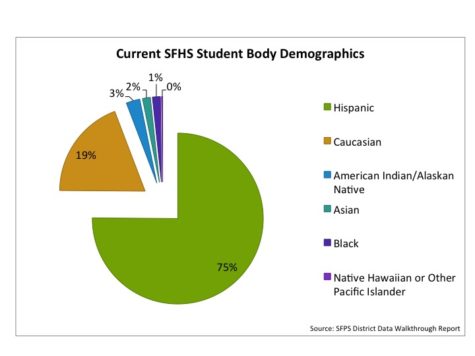
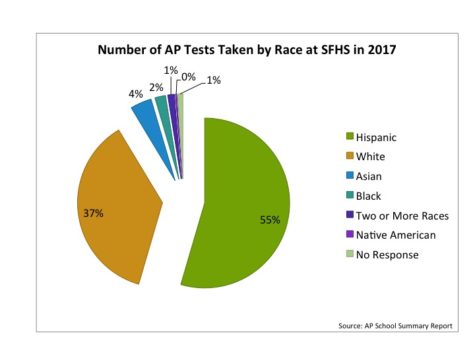
Although there have been some improvements in reflecting the student body in these courses, Mr. Eadie, who despite seeing a more representative population in his AP Human Geography and AP Psychology courses, recognizes that there is still work to do. “There are some AP core classes where we don’t see that same diversity,” he said. “In certain subjects we see it more than others.” He stated that he wants the program to become even more representative, but that it’s “a constant battle.”
Here is the race breakdown nationally and the races of students who took AP exams in 2017:
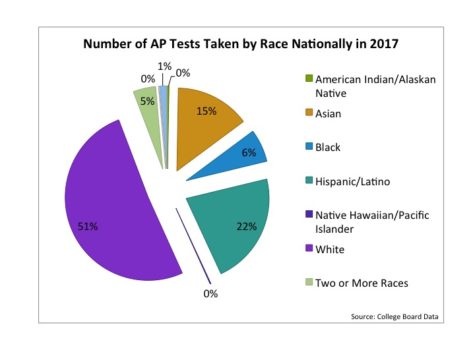
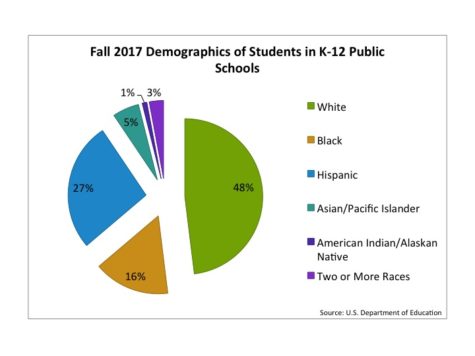
Assuming those numbers are more or less representative of the students eligible by age and who have access to take AP courses, one can see both positive and negative differences that vary among racial and ethnic groups, such as the positive 2.84 percent difference among whites and the 9.19 percent difference among Asians/Pacific Islanders, and the negative 9.38 percent difference among blacks and the 4.95 percent difference among Hispanics/Latinos.
Maxine, who identifies as black, has taken AP Art History, AP Psychology, AP Physics I and II, AP Chemistry, AP English Language, AP English Literature, AP U.S. History, AP U.S. Government and Politics, AP European History, AP Human Geography, and AP Computer Science. Although she learned about the AP program during a SFHS visit to her middle school, Capshaw, she feels that the student body as a whole isn’t aware enough of the opportunity.
“It’s more of a ‘you have to know about it’ kind of thing,” she said. “I’ve known about it since before I even started high school, so it was always just kind of a common thing for me. But [I think] they don’t really advertise it as much as they should, and so it’s definitely more like, if ‘you’re part of this group, then you’ll stay part of that group.’ But it’s really hard to find your way in.”
“There’s not a lot of new people coming in or out, so it’s just always the same people over and over and over again,” she continued, “like you know who’s going to be in your class, you know who you’re going to deal with, and for me that’s kind of upsetting. It would be really nice to meet new people in these classes that have the same interests.”
Oscar, who identifies as Hispanic, said that although it was easy for him to get enrolled in the courses and that he feels any student could get involved if they wanted to, he thinks there is also still a language barrier. “I feel really different when I’m in a Spanish AP class than in an English AP class,” he said, adding that to make English language learners feel more welcome in these classes, there should be more bilingual editions of AP classes. (In addition to AP Spanish Language and AP Spanish Literature, SFHS currently offers one other course taught in Spanish: AP Art History.
“It’s kind of sad,” he continued. “One thing I’ve noticed is that the AP teachers will try to get kids [who are native Spanish speakers] to join the AP Spanish classes because they can easily get good scores on the AP exam, making the school look good, but what about in the other classes?”
This linguistic obstacle is evident on a national level. According to that same 2017 report done by the Economic Policy Institute, “In 15 years of increasing average test scores, black-white and Hispanic-white student achievement gaps continue to close, and Asian students are pulling away from whites in both math and reading achievement.” However, it states, “Hispanic and Asian students who are English language learners (ELL) are falling further behind white students in mathematics and reading achievement.”
Here is how current SFHS students feel about the AP program:

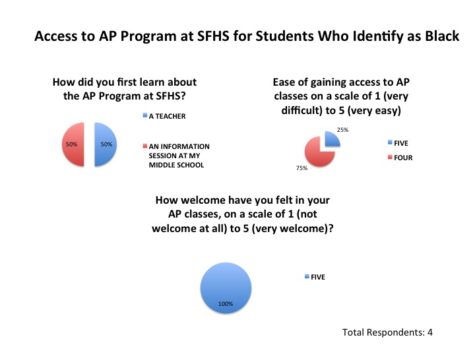
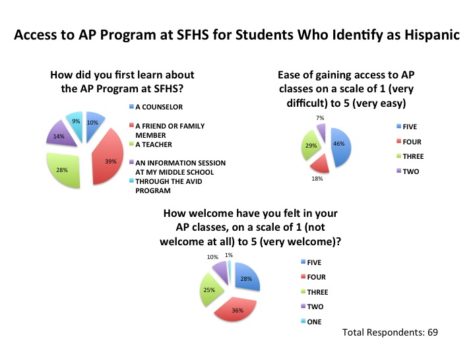
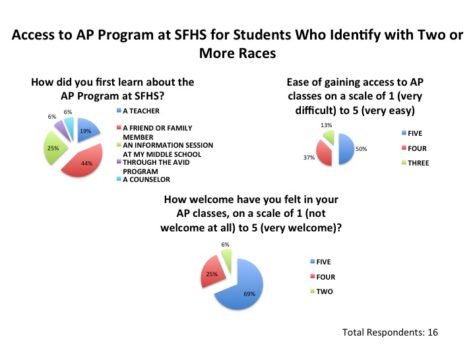

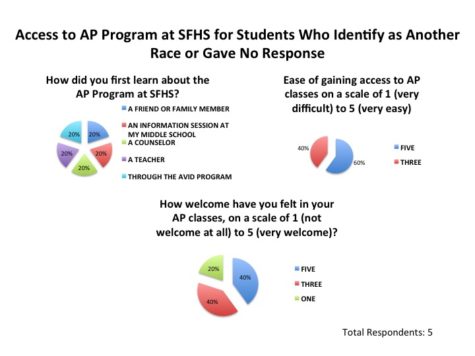
Despite efforts to improve diversity in the environment of these courses, Mr. Eadie said, “Sadly, I think a lot of people still check out when they hear ‘AP.’ They fall back on their automatic associations, those implicit biases that exist… and the stigma of AP, like when they hear it, they’re like, ‘Oh, no, no, that’s for the ‘smart’ kids,’ and that’s not at all what it is. It’s for the motivated kids, and you can be a motivated kid just like anybody else.”
“But they have to take it seriously,” he continued, “and sometimes there are community norms that don’t place an emphasis on education, and as a result, some students don’t value what they’re getting, and don’t take advantage of what they’re getting.”
Mr. Eadie thinks that prioritizing education — through initiatives such as increased education funding, increased salaries for teachers, and educator trainings — could help reduce this academic gap. “Essentially, we say to you, as a young person, that you’re worth about $3,500 a year. That’s not a lot.… For 12 years of education, that’s just not enough. Our community doesn’t funnel enough money into education to make this divide an issue, or to diminish the impact of this divide, to alleviate this divide.… Until we find a different funding formula that places a priority on education, we’re not going to have enough in the system to remedy this.”
“Kids are great regardless of where they are economically or what background they come from, and they all have the opportunity and should be given the right to a quality education,” Mr. Eadie added.
It’s a pressing — and complex — task, but as Oscar hopes, if and when the educational divide is fixed, the whole nation “will rise.”


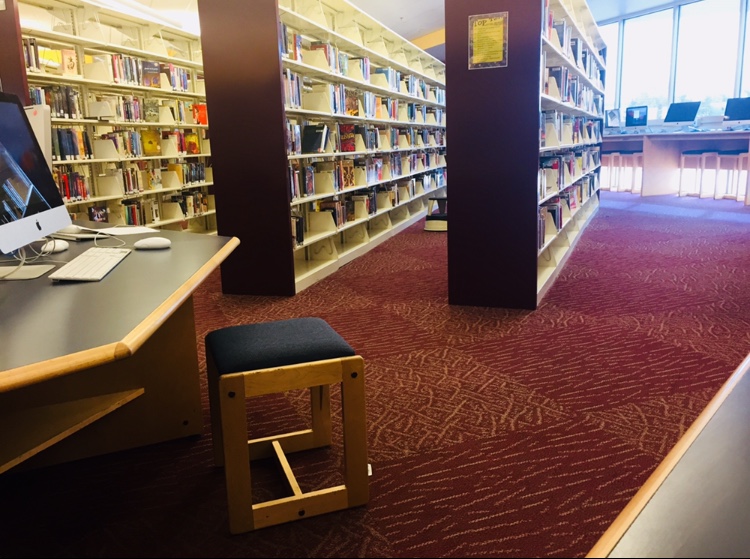
Carlos Caldwell • Apr 27, 2018 at 2:46 pm
Polling data! Nice work. Good story. Well balanced.